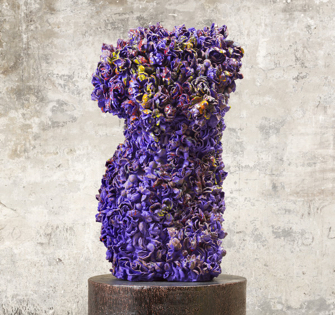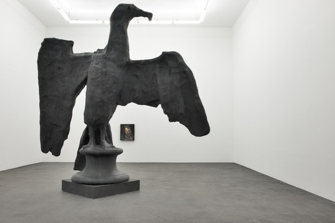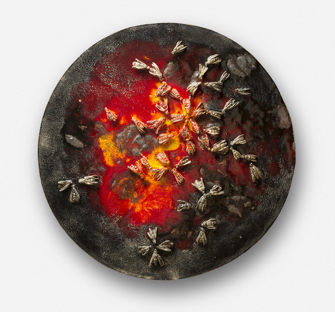
In 1988, Noëlle Tissier, an artist turned feisty culture warrior, set up the Villa Saint Clair in the Mediterranean fishing port of Sète as an incubator for budding talents. Among the younger fellow-artists she nurtured, many went on to win international fame. Philippe Perrin, Yan Pei-Ming, Jean-Michel Othoniel and Johan Creten were among the earliest alumni of the villa’s studio residency program.
This fall, the Flemish sculptor Creten has returned to Sète with a major solo retrospective of 55 works, mostly in ceramics but some in bronze or resin, dating from 1991 to the present. Curated by Tissier, the show opened last month and runs until January 29 at the Languedoc-Roussillon Centre Régional d’Art Contemporain (regional contemporary art center), another art space she created and now runs in an airy, modernist quayside loft.
Creten is not an easy artist. His work is wry, questioning, often anguished. The show’s opening work, “Pliny’s Sorrow,” is a giant black

bird, poised as if for flight but lumpy as a cormorant slicked in oil, with a broken wing.
Birds occur quite frequently in his work, and they are no sweetie-pies. In “Orgy,” a bright red cock-bird mounts a yellow hen beneath the semi-detached gaze of a couple of black crows. Sex bubbles beneath the surface, and it’s not a pure pleasure.
But if there’s suffering in the work, it is also shot through with beauty – in the richness of the ceramic glazes, resulting from multiple kiln

firings, and in the harmonies of surreal, metamorphic forms – half human, half fish or flower. In sculptures like those in his “Odore di Femina” series – sensuous feminine torsos composed of a dense carpet of sharp-petalled ceramic roses – there is a cathartic resolution of ambiguous relationships: desire and pain, humanity and nature. The imperfectly predictable quality of the ceramic glazing process adds its own resolution of binary dichotomies: accident and design, will and fate.
About four hours from Paris by direct TGV, Sète is a stretch for a day out of town, but for a weekend it has a lot going for it. Tissier opened her art center in 1997 with regional government funding, part of a strategy formulated to weave a cultural tourism strand into Sète’s working port economy at a time when fishing was going through a lean patch.
The strategy has worked well. Sète now boasts an open-air theater in a converted Vauban fort; a quality public art museum, the Musée Paul Valéry; the Espace Georges Brassens, devoted to the chansonnier, probably the town’s most famous native son, along with the poet Valéry; and a cluster of excellent, modestly priced quayside restaurants around the Criée market, serving fish fresh from the boats and local Bouzigues oysters from the Thau Lagoon, which flanks one side of the town. Oh, and the local white wines are pretty decent, too.
Favorite
